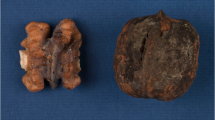Abstract
Twenty-six young men with no previous medical history all ingested mushroom soup, exclusively made withCortinarius orellanus. They were hospitalized 10–12 days after the incident. On admission, 12 patients presented with acute tubulointerstitial nephritis with acute renal failure; 8 required haemodialysis. In addition to symptomatic treatment, 9 patients were given corticosteroids. In this group of 12 patients, 8 recovered rapidly, and the other 4 suffered from chronic renal failure for several months. In the other group of 14 patients, initial leukocyturia was observed in 12 cases, although renal function remained normal during a one-year follow-up. Hepatic acetylation and hydroxylation tests performed after 6 months in 22 patients did not provide any explanation for the strong individual sensitivity to the renal toxicity of this fungus.
Similar content being viewed by others
References
Grzymala S (1965) Etude clinique des intoxications par les champignons du genereCortinarius orellanus Fr. Bull Med Leg Toxicol Med 8:60–70
Brousse A, Herve JP, Leguy P, Cledes J (1981) L'intoxication par champignons de typeCortinarius orellanus — une cause rare d'insuffisance rénale. Presse Med 10:1940 (lettre)
Delpech N, Rapior S, Cozette AP, Ortiz JP, Donnadieu P, Andary C, Huchard G (1990) Evolution d'une insuffisance rénale aiguë par ingestion volontaire deCortinarius orellanus. Presse Med 19:122–124
Farber D, Feldmeier S (1977) Die Orellanuspilzvergiftungen im Kindesalter. Anesth Praxis 13:87–92
Favre H, Leski M, Christeler P, Vollenweider E, Chatelanat F (1976) LeCortinarius orellanus: un champignon toxique provoquant une insuffisance rénale aiguë retardée. Schweiz Med Wochenschr 106:1097–1102
Marichal JF, Triby F, Wiederkehr JL, Carbiener R (1977) Insuffisance rénale chronique après intoxication par champignon de typeCortinarius orellanus Fries; deux cas d'intoxication familiale. Presse Med 6:2973–2975
Busnach G, Dal Col A, Perrino ML, Surian M, Rovati C, Barbiano di Belgioioso G, Minetti L (1983) Plasma exchange in acute renal failure byCortinarius speciosissimus. Int J Artif Organs 6:73–74
Holmdahl J, Mulec H, Ahlmen J (1984) Acute renal failure after intoxication withCortinarius mushrooms. Hum Toxicol 3:309–313
Hulmi S, Sipponen P, Forstrom J, Vilska J (1974) Mushroom poisoning caused byCortinarius speciosissimus — a report of four cases. Duodecim 90:1044–1050
Short AIK, Watling R, MacDonald MK, Robson JS (1980) Poisoning byCortinarius speciosissimus. Lancet II:942–944
Gerault A (1981) Intoxication collective de type Orellanien provoquée parCortinarius splendens R. Hy. Bull Soc. Mycol France 97:67–72
Price Evans DA, White TA (1964) Human acetylation polymorphism. J Lab Clin Med 63:394–403
Idle J, Mahgoub A, Angelo M, Dring L, Lancaster R, Smith R (1979) The metabolism of14C-debrisoquine in man. Br J Clin Pharmacol 7:257–266
Michelot D, Tebbett IR (1988) Les intoxications par les cortinaires. Cryptogamie Mycol 9:345–361
Prast H, Pfaller W (1988) Toxic properties of the mushroomCortinarius rellanus (Fries). II: impairment of renal functions in rats. Arch Toxicol 62:89–96
Linton AL, Richmond JM, Clark WF, Lindsay RM, Driedger AA, Lamki LM (1985) Gallium 67 scintigraphy in the diagnosis of acute renal disease. Clin Nephrol 24:84–87
Schumacher T, Hoiland K (1983) Mushroom poisoning caused by species of the genusCortinarius Fries. Arch Toxicol 53:87–106
Tebbett IR, Caddy B (1984) Mushroom toxins of the genusCortinarius. Experientia 40:441–446
Richard JM, Louis J, Cantin D (1988) Nephrotoxicity of orellanine, a toxin from the mushroomCortinarius orellanus. Arch Toxicol 62:242–245
Nieminen L, Pyy K (1976) Sex differences in renal damage induced in the rat by the Finnish mushroomCortinarius speciosissimus. Acta Pathol Microbiol Scand 84:222–224
Neilson EG (1989) Pathogenesis and therapy of interstitial nephritis (nephrology forum). Kidney Int 35:1257–1270
Andary C, Rapior S, Delpech N, Huchard G (1989) Laboratory confirmation of cortinarius poisoning. Lancet I:213 (letter)
Heath A, Delin K, Eden E, Martensson E, Selander D, Wichstrom I, Ahlmen J (1980) Hemoperfusion with amberlite resin in the treatment of self-poisoning. Acta Med Scand 207:455–460
Nieminen L, Pyy K, Hirsimaki Y (1976) The effect of furosemide on the renal damage induced by toxic mushroomCortinarius speciosissimus in the rat. Br J Exp Pathol 57:400–403
Author information
Authors and Affiliations
Rights and permissions
About this article
Cite this article
Bouget, J., Bousser, J., Pats, B. et al. Acute renal failure following collective intoxication byCortinarius orellanus . Intensive Care Med 16, 506–510 (1990). https://doi.org/10.1007/BF01709401
Received:
Accepted:
Issue Date:
DOI: https://doi.org/10.1007/BF01709401




